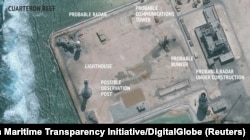The Chinese military is building anti-aircraft and anti-missile systems on the artificial islands it has constructed in the South China Sea, in what analysts believe is a prelude to deploying combat aircraft to the disputed territory, according to a U.S. research organization.
"This is further evidence that the commitment that President Xi Jinping made to President [Barack] Obama last year not to militarize these islands was, at best, premature," Asia Maritime Transparency Initiative (AMTI) Director Gregory Poling told VOA in an interview Wednesday. "This is clearly advanced preparation to arm these islands in case of an armed conflict."
While upgrades cannot be considered offensive weaponry “even these systems would violate the pledge Xi made at the White House,” concurs Georgetown University Professor Dennis Wilder, a former senior director for East Asian affairs at the National Security Council.
The conclusion that new weapons systems have been placed on the reefs results from months of analysis of commercial satellite imagery, according to AMTI.
"We can see that these are emplacements for anti-aircraft guns. If the barrel of a gun is long enough that you can see it from space, then it's pretty big," said Poling.
Defense system
Also evident are close-in weapons systems, most likely for missile defense.
"If you imagine that you have surface-to-air missiles to protect against any incoming cruise missiles, then anything that gets through would face these guns. This is not something you build if you don't intend to defend these islands," Poling said.
At the State Department, spokesman John Kirby told VOA in response to a question about the fresh satellite imagery: “There should be no need for militarization of these manmade features. And we’re going to continue to make that case at every possible turn.”
AMTI had been tracking construction of hexagonal structures on Fiery Cross, Mischief and Subi reefs in the Spratly Islands, where China has already built long airstrips, since June and July.
China's Defense Ministry issued a statement Thursday on its website, saying the construction was "mainly for civilian use."
"As for necessary military installations, they are mainly for defense and self-protection and are legitimate and lawful," it added.
Images of Fiery Cross Reef also reveal towers that most likely contain targeting radar, according to the analysis.
"They're not even close to done. Most of these islands — the big ones, Mischief Reef, Subi Reef and Fiery Cross Reef, the ones that are being turned into air bases — there's still a lot of empty real estate there. They're going to continue to build," Poling predicted. "What we're seeing is the most important critical infrastructure going in for air and for defense. Pretty soon I expect that we'll see deployment of combat aircraft. We'll probably see deployment of mobile surface-to-air [SAM] missiles like the HQ-9s that were sent to Woody Island last year."
Fox News recently reported that components for SAM systems were spotted at the Chinese port of Jieyang, in Guangdong province, possibly destined for the South China Sea.
"I think it is proof against those in the U.S. and elsewhere who have shrugged off these facilities and said, 'Ah, they're no big deal. You could take care of these quickly.' That's clearly not the case," Poling said.
Analysts say what would be even more significant is if China would place fighter jets and long-range missiles on the small islands.
“I have doubt that they’re actually going to take that next step,” Wilder, a former CIA analyst of China’s military, told VOA. “That would alarm China’s neighbors and would be very offensive in nature.”
Therefore, for now at least, the new weapons spotted on the reefs “are more of a political problem than a military problem,” Wilder added.
U.S. government aware
The imagery released Wednesday by AMTI, which is affiliated with the Washington-based Center for Strategic and International Studies, is certainly no surprise to the U.S. government.
"By the time we've identified something on commercial imagery, the intelligence communities here and in the region have presumably been aware of it for quite some time," Poling said.
The incoming administration of U.S. President-elect Donald Trump has given signals it intends to take a tougher approach to Chinese assertiveness in the disputed waters.
America's commitment to the region will continue under Trump's presidency, the commander of U.S. military operations there pledged Wednesday.
The U.S. military also will not soften its opposition to Chinese expansion in the South China Sea, said Admiral Harry Harris Jr., head of the U.S. Pacific Command.
"You can count on America now and into the future," Harris said in a speech at the Lowy Institute in Sydney, Australia. "Reports of America's abandonment of the Indo-Asia-Pacific have been greatly exaggerated."










